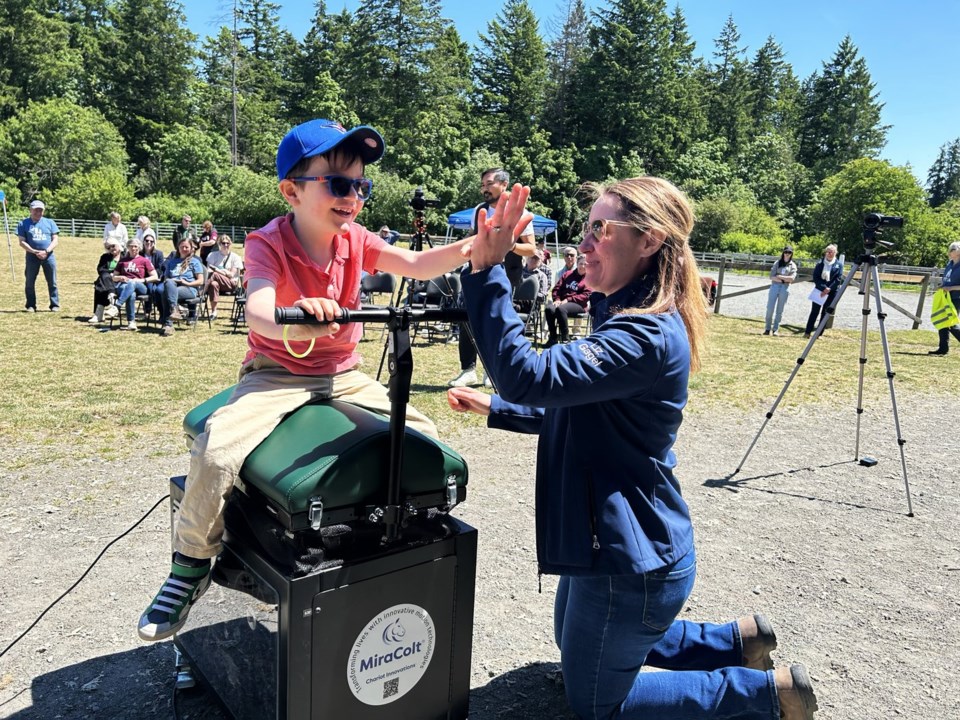VICTORIA — "Do you want to go faster?"
Jayne Imeson already knew the answer she was going to get from her six-year-old son, Casey, sitting astride his new steed in a park in Central Saanich, B.C.
He nodded with a smile. "Always faster -- this kid loves his speed," Imeson said.
Casey's usual ride is a Fjord horse named Valla, but on Thursday, he became the first official user of the MiraColt horse-riding motion simulator developed for the Victoria Therapeutic Riding Association.
The first-of-its-kind device combines a commercially available riding simulator with an app-based software application designed by CanAssist, an organization that is part of the University of Victoria, dedicated to helping people with disabilities.
The system allows riders to control the speed of their simulated ride through a variety of virtual trails. The university says it's aimed particularly at those unable to ride a real horse.
Casey has cerebellar ataxia affecting his muscle control but he can ride Valla at the Victoria Therapeutic Riding Association, which has 13 horses of different sizes and kinds.
But Casey's toothy grin as he rode the MiraColt suggested it was a good substitute.
Users who straddle and sway on the device the size of a large suitcase can pick the scene displayed on a screen -- a local park, an urban street or the Arizona desert.
"It replicates the movement of a horse at the gait of a walk," said Liza Gagel, executive director of the Victoria Therapeutic Riding Association.
"It can go from a very slow walk to a very, very fast walk, and the walk is actually the most beneficial gait for therapeutic purposes, for both physical and mental movement."
Gagel said the simulator had the promise to help her organization meet growing demand.
"We are limited by the number of hours in a day and horses we have and staff we have," she said.
"So we are trying to figure out how we are going to meet the needs of our community and then CanAssist showed up at the right time."
About 230 participants take part in the riding association's program, with another 50 people waiting, Gagel said.
"We don't know where we are going to add those people, so we are working with our committees right now to see how many of those people could do the simulator rather than the riding lessons, and then we can have people trade in and trade out," she said.
Gagel said the simulator would allow riders to warm up their muscles and improve core strength before hopping on a genuine horse.
She added that it would allow others with behavioural challenges to release some of their energy before riding a real horse.
Unlike a real horse, the simulator can also easily move to other locations. "We can actually pick it up and take it to clinics or a physiotherapist office or people's homes, if that is a need," Gagel said.
Imeson, Casey's mother, has seen the benefits of therapeutic riding.
Casey has been riding with the association for two years and the improvements have "truly been incredible," Imeson said.
"When he is in session here ... he's always improving his abilities and his balance and his motor skills and his reflexes," she says. "It's leaps and bounds," she adds.
Imeson said she believes that the simulator would help her son make additional gains.
"It does an incredible job of replicating the horse movement," she said.
The simulator is the third project between the riding association and CanAssist during a 15-year collaboration with two local donors, Lynda and Murray Farmer, covering the full cost of the project, which is undisclosed.
This report by The Canadian Press was first published May 23, 2025.
Wolfgang Depner, The Canadian Press




